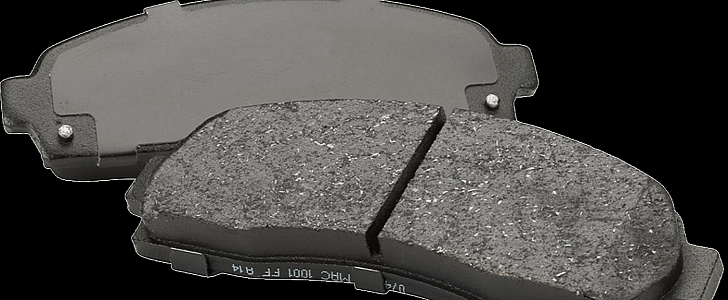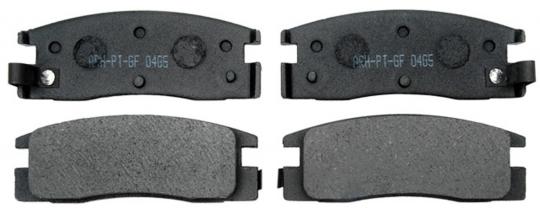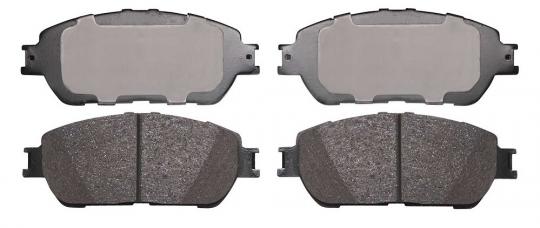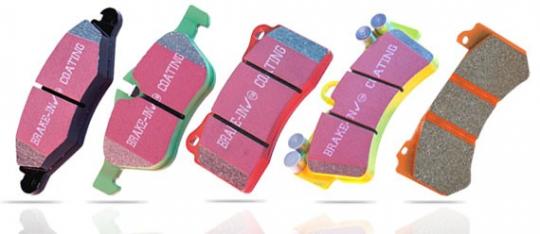Brake pads are consumables that are vital to the braking system. Just like brake fluid, they are often overlooked, and the consequences can be disastrous.
Brake Pads: Organic, Ceramic, And Semi-Metallic – What Are The Differences

The brake pads have the role of gripping the brake discs to reduce their velocity. They are placed in brake calipers, and the parts that push the brake pads on the discs are called pistons. Just like other consumables, brake pads suffer from wear, and they need to be replaced before they go below a minimum level.
In the case of brake pads, their wear is measured by the thickness of the layer of friction material. That material is what helps a brake disc slow down and stop whenever the brakes are used, but also when traction control or ESP kicks in to slow down one of the wheels.
The friction material used by brake pads determines their type. All brake pads rely on a metallic plate that has friction material on it, but the composition of the said material dictates how those pads will operate. There is no general rule regarding brake pad composition to say that a particular type is the best, and all the others are inferior.
The best brake pads for your vehicle depend on what you need those parts to do. Some pads are better for day-to-day driving in all weather conditions, while others are designed only to be used on the track. In the case of the latter, even if their level of performance is incredible when compared to regular ones, it is illegal to use them on public roads.
The reason lies in the composition of racing brake pads, which is designed to operate in particular conditions, which are incompatible with day-to-day use. We will detail this below, along with other vital information about brake pad types and uses for most production vehicles.
Before we go into specifics, we urge you to have your brakes checked at frequent intervals when you take your vehicle to the shop for maintenance work, but also when you observe that braking performance is inconsistent or deteriorating.
Never skimp out on brake pads, and always make an informed purchase. Cheap knock-offs are the worst parts you could buy for your vehicle. It is best to leave it parked than to fit counterfeit brake pads, discs, or other components.Organic Brake Pads

Before the 1970s, all brake pads had asbestos in them. The substance was proven to be dangerous to human health, so it was banned in this product, as well as other areas of industry. With the disappearance of asbestos pads came the Organic Brake Pad.
These pads do contain between 10 to 30% metal, but the rest of the friction material comes from plant-derived fibers, high-temperature resins, and other materials. Depending on the proportion of metal in them, they might also have Kevlar, carbon, rubber, and even glass in them.
There is also a kind of organic brake pad called a Low-metallic NAO, which refers to Non-Asbestos Organic, which comes with more metal than the “fully organic” ones, and also bring an enhanced capability of heat transfer.
Most volume manufacturers and premium manufacturers fit their cars from the factory with Organic Brake Pads, but this only refers to over 50% of new vehicles. Others employ different types of brake pads from the production line. Semi-Metallic Brake Pads

The second type of brake pad friction material is named “semi-metallic.” The reason for this is because they feature from 30 to 65% metal by weight. Multiple types of metal are used, from copper and iron to steel. The rest of the friction surface is made of fillers, modifiers, and other substances required to enhance performance and maintain reliability.
This type of brake pad friction material is extremely popular among automakers, and they are considered to be the most versatile type of brake pad on the market. They have their disadvantages, evidently, but some believe that getting semi-metallic brake pads is the best option. It all depends on the application.
Before the appearance of ceramic brake pads, semi-metallic pads used to be the best performing pads available on the market. Evidently, some of that advantage has disappeared with new technology, but they still can keep up with their superior competitors from many points of view. Ceramic Brake Pads

Initially, the ceramic friction material for brake pads was developed as a replacement for both organic and semi-metallic parts. This has not happened yet, but there is a good reason for that. Ceramic brake pads are the most expensive you can buy, and their abilities are not suited for all the consumers targeted by suppliers and automakers.
Instead of the organic material found the first type of brake pad described above, these components have a dense ceramic material. Do not think of glass, but something similar to pottery that is made in a kiln, which is mixed with copper (or other metal) fibers. Together, the combination of materials provides better performance, and they are more silent than the other types.
Ceramic brake pads are appreciated for their long lifespan, as well as stable and consistent performance throughout their operating life. However, these pads are sometimes criticized for the “feel” they provide in operation, but also for reduced effectiveness in cold climate when compared to semi-metallic pads.
This type of brake pad must not be confused with carbon-ceramic braking systems, which are found in supercars. Some high-end sports cars offer them as optional equipment. They come with ceramic pads, but the discs are made with composite materials instead of cast iron. They provide the highest level of performance available in cars, but also come at a hefty cost, and need to be warmed up for optimal performance.Pros&Cons of brake pad types

We explained in the introduction of the story that the perfect brake pad has not been invented yet. There is no one-for-all solution for all applications, just like the USB (Universal Serial Bus) is not that “universal” if we look at all of its derivatives made over time.
It all depends on what you want to do with the vehicle that needs new brake pads. Commuters can have enough performance from Organic pads, but Semi-Metallic or even Ceramic pads can also suit their needs.
Most organic pads generate good friction without having the need to be warmed up in any way, and they are also the most affordable on the market.
Unfortunately, things are not so good with organic pads as you demand more from your brakes, as they can make the pedal feel “mushy” when driving hard, and they honestly do not cope well with performance driving. Organic brake pads also tend to wear faster than other types, but at least they make less dust and are quieter than semi-metallic units.
If the vehicle you are driving is meant for heavy loads, you can just forget about organic pads, and get semi-metallic ones. The same goes for drivers that want more performance in off-road conditions. Drivers that want more braking performance on the street will have to make the puzzling choice between ceramic and semi-metallic brake pads.
The latter come with increased wear on the rotors, more noise, and more dust. Meanwhile, the ceramic units have a longer service life, but come with the drawback of less performance than semi-metallic friction material while also being more expensive.
Things get even more tricky when you are looking for pads meant for sporty cars that go for the occasional track day. The ceramic pads might need to be warmed up before being used to their full potential, and they also do not have the same heat absorption and dissipation capabilities.
The two drawbacks presented in the previous sentence mean that other elements of the braking system will tend to heat up faster, leading to less performance.
The major advantage of ceramic brake pads comes in the form of the longer lifespan and temperature stability over a broad range of uses. For example, if you just want a few laps on a small track and then go back to daily driving, ceramic pads might be better for you.
If you have a bigger circuit at your disposal and like to get more performance on it, with the downside of more brake dust and noise, you should get semi-metallic pads. The same kind of brake pads also generates more wear on the brake rotors, but also provides more "bite" and feeling when pressing the pedal.
At the end of the day, remember to consult with the manufacturer of the brake pads or a specialist in braking systems before getting new pads installed on your vehicle.
For regular drivers, the organic pads might be the best, with the option of getting ceramic pads as an upgrade. Sporty cars with enthusiastic drivers must opt between semi-metallic or ceramic brake pads depending on their needs and desires. Choose wisely and stay safe on the road and the track.








